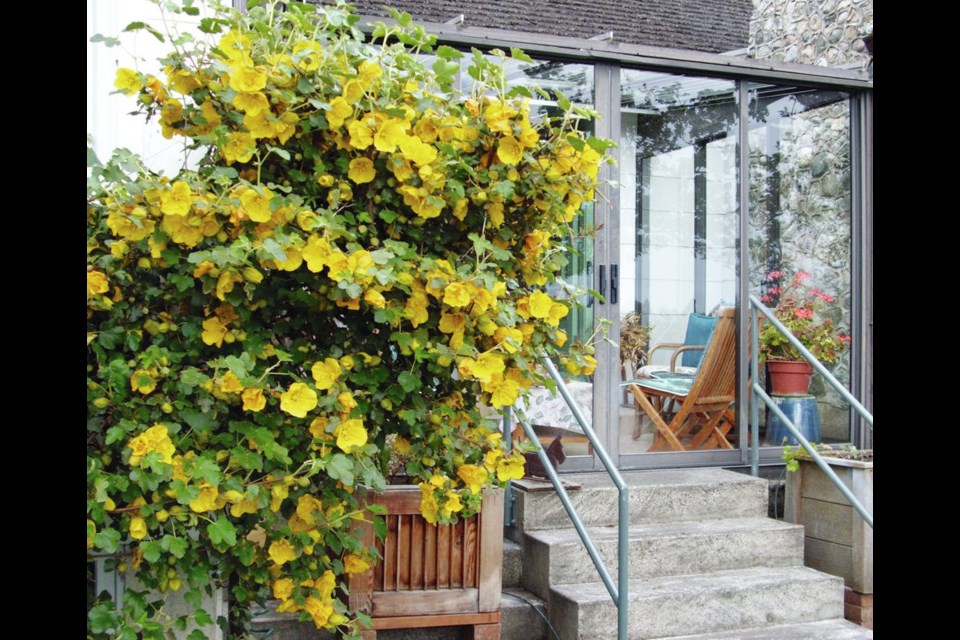Dear Helen: I’ve long admired Fremontia plants that I’ve seen in bloom, and I’ve noticed that you have written about this shrub. Friends have warned me against acquiring one because they are difficult plants. Do you agree?
L.S.
Deciding whether or not to plant a Fremontia calls for a careful risk/benefit calculation. The shrub (or multi-trunked tree) is fast-growing, evergreen, and glorious during its May and June display of large, canary yellow flowers. Once established, it is drought tolerant.
Disadvantages include fine, fibreglass-like hairs that coat young stems and the undersides of the lobed, olive green leaves that are thick like flannel. A name sometimes used for Fremontia is flannel bush. The hairs are irritating to skin, throat, and eyes. One reader wrote to say she’d removed her plant from the garden because of this issue.
The other main problem is that the plants are shallow-rooted and prone to toppling over in fall and winter storms or under the weight of snow. My Fremontia has fallen over three times.
Part of the problem is that the plants grow fast and, because of the irritating hairs, are not pleasant to prune. I had meant, early in the fall, to reduce the dimensions of my tall Fremontia, but I did not manage to get it done. As a result, the top-heavy shrub crashed over onto the driveway in a pre-Christmas snowfall. Luckily, my son Chris and I managed to prune it back and stake it upright shortly after.
Regular post-bloom pruning helps to keep a Fremontia within manageable bounds, but for safety and comfort it is best to prune after either a heavy rainfall or a thorough hosing down. Wear goggles, face mask, a broad-brimmed hat, and rain gear.
I made the mistake of pulling down my mask momentarily during the recent pruning. Prickly throat ensued, and as soon as we finished the project, Chris headed straight to the shower to be rid of the hairy itching.
Is it worth it? For me, yes, but not everyone would agree.
Dear Helen: Can you recommend a specimen evergreen for a small area, open to sun and rain? The junipers that were in the site grew too big and had to be removed. A plant 1.2 to 1.8 metres tall and wide, preferably one needing no pruning or other attention, would be perfect.
H.E.
I’m presuming you are looking for another coniferous evergreen to replace the junipers. Taste in plants is highly personal. Small conifers come in various shapes. Needle texture differs among them, as does colouring that includes many shades of green, blue-green and gold.
To begin seeking an ideally suitable specimen plant, consider typing its desirable features into a search engine. In your case that would be “specimen conifer 1.2 to 1.8 metres tall and wide.”
When I did this, I found a selection of likely plants on the Monrovia site — a good one to look at because Monrovia is a major supplier of plants to our local garden centres.
I liked the dwarf globe blue spruce, a densely branched, bright blue, globe shaped shrub that is a slow grower 1.5 metres tall and 1.8 metres wide. There’s a beautifully rounded dwarf Scotch pine, and a dwarf blue Rocky Mountain fir that has soft blue needles and grows in a dense, pyramidal form.
This is a good way to get an idea of what might be available in plants with the characteristics you desire. Then visit a few garden centres to see what is currently on display and to inquire about the plants that attracted you in your online research.
You will have trouble finding an entirely no-care plant. Even drought tolerant plants need watering for at least the first year in a garden, as they set up a robust root system. Slow-growing plants reduce pruning demands but don’t necessarily eliminate them.

Dear Helen: I still can’t understand how to prune figs. What is “first year wood?” Does it bear the figs?
K.P.
First year wood is the newest growth, produced in the current season. It carries a late (second) crop that does not ripen in our climate; however, that same growth, in its second year, will bear the early (first) crop that ripens in August. That second-year growth is what you want to retain, though some of it can be thinned out if crowding is severe enough to limit air circulation and sunlight penetration to the developing and ripening fruit.



